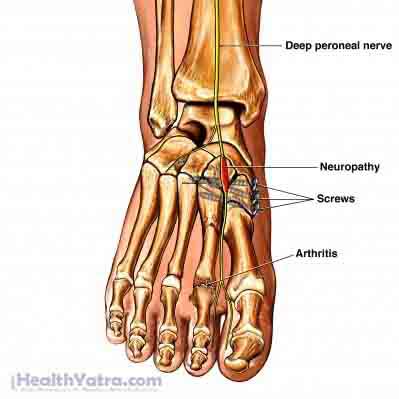Definition
The peroneal nerve is found on the outside part of the lower knee. This nerve is responsible for transmitting impulses to and from the leg, foot, and toes. When damaged, the muscles may become weak. A condition called foot drop can occur. Foot drop is the inability to raise the foot upwards.
The sooner a peroneal nerve injury is treated, the better the outcome may be. If you suspect you have this condition, contact your doctor promptly.
Causes
A peroneal nerve injury is commonly caused by an injury to the leg. Other causes include:
- Trauma to the nerve that can occur with:
- Broken leg bone
- Knee injury
- Surgery to leg or knee
- Ankle injuries

- Prolonged pressure on the nerve, common from:
- Sitting position (ie, crossing your legs)
- Cast on lower leg, particularly if it is too tight
- Masses (including blood clots, tumors)
- Nerve damage caused by conditions such as:
- Diabetes mellitus
- Infection
Risk Factors
These factors increase your chance of developing a peroneal nerve injury. Tell your doctor if you have any of these risk factors:
- Recent trauma to leg
- Frequently sitting with legs crossed
- Long periods of bedrest
- Recent weight loss
- Diabetes
- Polyarteritis nodosa (inflammation in blood vessels)
- Exposure to certain toxic chemicals
- Styrene
Symptoms
If you have any of these symptoms do not assume it is due to a peroneal nerve injury. These may be caused by other conditions. Tell your doctor if you have any of these:
- Numbness
- Tingling
- Pain in foot or shin
- Foot weakness
- Prickling sensation
- Pins and needles sensation
Diagnosis
Your doctor will ask about your symptoms and medical history. A physical exam will be done. An important part of your physical will be checking how well your nerves and muscles are working in certain parts of your leg. You will be asked to move your leg and foot in certain ways. Your doctor may want to watch you as you walk. You may be referred to a neurologist, a doctor who specializes in the nervous system.
Tests may include the following:
- X-rays —test that uses radiation to form an image; used to rule out a back problem
- MRI scan —test that uses magnetic waves to form an image; used to look for masses involving the nerve
- Nerve conduction studies and electromyography (EMG)—test that assesses how well the nerves and muscles work
Treatment
Talk with your doctor about the best plan for you. Options include the following:
Physical Therapy
A therapist will work with you to strengthen your leg and foot muscles.
Orthotics
An ankle and foot brace is used to treat foot drop.
Surgery
In some cases, surgery is used to treat a peroneal nerve injury. Surgical options include repairing the nerve, taking pressure off the nerve (decompressive surgery), or grafting a new nerve into place.
Prevention
Avoid crossing your legs to help reduce your chance of getting a peroneal nerve injury.
